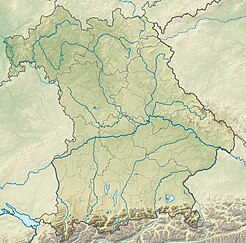Weilheim ground station
|
Weilheim ground station
|
||
|---|---|---|
| Basic data | ||
| Place: | Wielenbach | |
| Country: | Bavaria | |
| Country: | Germany | |
| Altitude : | 606 m above sea level NHN | |
| Coordinates: 47 ° 52 '51.6 " N , 11 ° 4' 58.8" E | ||
| Use: | Telecommunication system , military use | |
| Accessibility: | Transmission system not accessible to the public | |
| Owner : | German Aerospace Center | |
| Data on the transmission system | ||
| Number of towers / masts: | 12 | |
| Wavebands : | SW transmitter , FM transmitter | |
| Send type: | Directional radio | |
| Position map | ||
|
|
||
The Weilheim satellite ground station of the German Aerospace Center (DLR) is located near the city of Weilheim in Upper Bavaria . While the administration building is in the Weilheim area, the antennas and technical building of the system are in the Wielenbach municipality in the Weilheim-Schongau district . It is part of the DLR organizational unit (OE) Communication & Ground Stations (KB) of the German Space Operations Center (GSOC) in Oberpfaffenhofen. In addition to the ground stations, this also provides the communication network and the necessary data processing systems for manned and unmanned space missions . The ground stations support projects by providing telemetry , command and orbit tracking data for stationary and orbiting satellites and space probes .
The Weilheim ground station is the primary ground station for the COMSATBw satellites of the Bundeswehr .
30 meter antenna
The 30 m antenna was built and certified for deep space missions. The antenna was used to monitor the two Heliossondes in the 1970s, which were the first German probes. During this time it was integrated into the DSN of NASA. The facility was also used for the Voyager program until the removal of Jupiter. The antenna has a mass of 360 t and an alignment accuracy of 0.001 °, at times the system had two S-band transmitters, each with 20 kW transmission power. The facility was not used for many years, but continued maintenance. In 2004 the antenna was renovated.
This antenna has a wide reception range with receivers for L, S, C and X bands in the frequency range of 1,000–8,440 MHz. Depending on the design, components can easily be used or exchanged in test operation. The missions supported include B. the Hayabusa 2 mission of the Japanese space agency JAXA . The antenna is also used to monitor the signal quality of the GPS , GALILEO and Glonass navigation systems. The antenna can be connected to the ESTRACK and is then operated from ESOC in Darmstadt.
There are plans to fully integrate the antenna into the ESTRACK network, for this purpose a test operation has been running since 2019, signals from Gaia and Mars Express were received. The antenna can be equipped with a new transmitter for this purpose. Due to its characteristics, the antenna could be used for lunar missions or missions to the Lagrange points. "
More antennas
At the end of 2017, the Weilheim ground station had the following active systems:
- 15 m S-band antenna
- 15 mS band antenna with reception in X band
- 13 m Ka-band antenna
- 11 m Ku-band antenna
- 9 m S-band antenna. Can also be operated as an imaging radar station.
- 2 × 6.8 m Ka-band antennas. These antennas are reserved for the connection to EDRS . One of them is equipped with a transmitter and receiver, the other only with a receiver. Another of these antennas is located in Redu, Belgium, and one in Harwell , UK as a backup. All four antennas are operated from GSOC in Oberpfaffenhofen.
The data communication takes place via redundant data lines to Oberpfaffenhofen. To secure communication, the Weilheim station has an uninterruptible power supply, which draws power from batteries for a short time in the event of a failure in the public power grid and from a 1,250 kVA diesel generator in the event of longer failures. The systems are looked after in shifts around the clock, seven days a week.
tasks
A special focus is on the planning, construction and operation of a worldwide communication network for the transmission of data, voice and video signals. DLR's own satellite systems as well as other leased lines are used for this purpose.
As part of the construction and operation of control centers, OE KB is responsible for creating basic software for handling space missions as well as for simulation and tests. Checkout and control systems are developed and operated for external clients.
By participating in international committees, it contributes to the standardization of
- Data systems ( CCSDS ) and
- Coordination of Frequency Matters (SFCG)
Web links
- Weilheim ground station on the DLR website
- Satellite ground station Weilheim Weilheim , DLR brochure (PDF)
Individual evidence
- ↑ Jerzy Zywicki: COMSATBw1 successfully put into operation. DLR, accessed on November 28, 2017 .
- ↑ DLR (Ed.): Satellite ground station Weilheim . ( dlr.de [PDF]).
- ↑ Hermann Hagn, Gerhard Metz, Hanspeter Kuhlen, Dominik Kuhlen: The 30-meter deep space antenna at DLR-GESOC in Weilheim / Obb. as a ground station for phase 5 mission Mars. (PDF) Archived from the original on December 26, 2005 ; accessed on November 28, 2017 .
- ↑ esa: ESA and DLR in joint study to support deep space missions. Retrieved July 6, 2019 (UK English).
- ↑ Antennas in Weilheim. DLR, accessed on November 28, 2017 .
- ^ The Weilheim location of the DLR. In: DLR Portal. DLR, accessed on December 11, 2017 .



